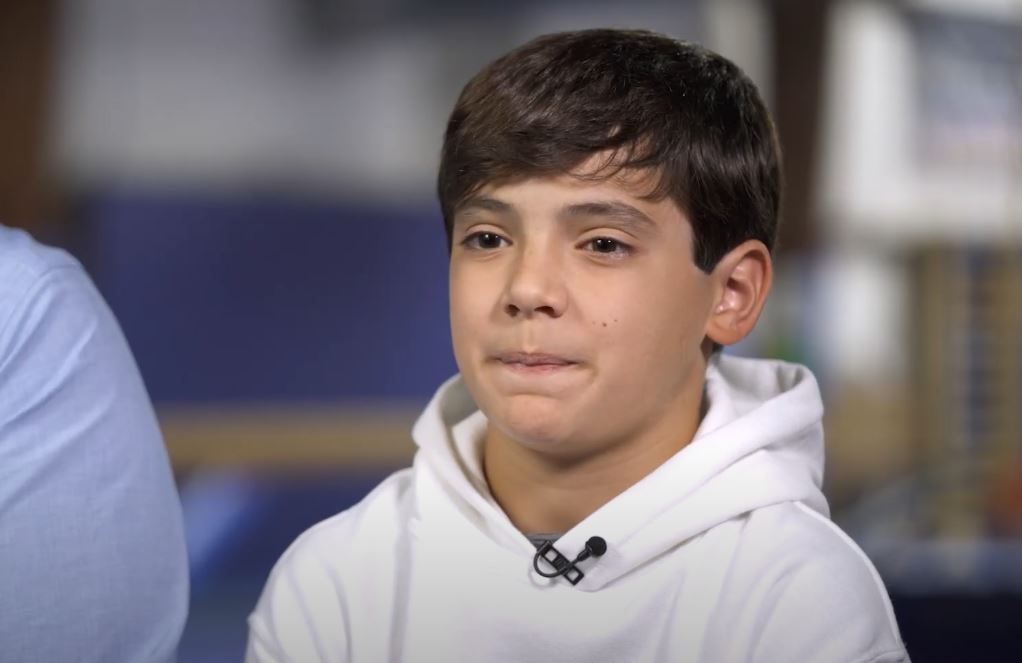
Vincent Michael Canales, the son of Dominique Moceanu, is establishing his own legacy with the silent but effective direction of parents who recognize the delicate relationship between skill, self-control, and emotional health. He was born in 2009 and has already demonstrated that he carries his father’s technical mastery and mother’s artistic talent in a very successful way. His story, which is still being told, reflects both family pride and a broader cultural interest in athletes from the second generation who are reinventing their sport.
At eleven years old, Vincent made his debut on American Ninja Warrior Junior, earning a coveted spot among thousands of competitors. His performance demonstrated his innate strength and concentration, which were remarkably similar to Dominique’s own willpower at the age of 14, which helped her become the youngest U.S. national champion. That early exposure was especially helpful because it gave him a platform to showcase his abilities and let the gymnastics community know that a new competitor was on the rise.
| Category | Details |
|---|---|
| Full Name | Vincent Michael Canales |
| Date of Birth | 2009 |
| Age | 15 (as of 2024) |
| Parents | Dominique Moceanu (Olympic gold medalist), Dr. Michael Canales (podiatrist, former gymnast) |
| Siblings | Carmen Noel Canales, younger sister born in 2022 |
| Sport | Men’s Artistic Gymnastics |
| Training Base | Dominique Moceanu Gymnastics Center, Medina, Ohio |
| Notable Highlights | American Ninja Warrior Junior (2020), national junior competitions, media features |
| Olympic Goal | Aspiring to compete at the 2028 Los Angeles Summer Olympics |
| Mentorship | Trained directly by both parents, blending artistry with technical guidance |
Vincent gains from a very effective system based on family values while training at the Dominique Moceanu Gymnastics Center in Ohio. Dominique contributes incredibly clear insights into artistry and performance psychology, while his father, a former collegiate gymnast who is now a podiatrist, refines the technique. When combined, they create a coaching model that is not only very adaptable but also noticeably better than the strict regimes of previous decades.
Dominique has utilized her position in recent days to remind followers that her son’s path will require patience and moderation. “Son, the road to Olympic dreams is built on hard work & steadfast belief,” she wrote on social media following the 2024 Summer Olympics in Paris. That message struck a chord well beyond their immediate family, especially in a sport that is still getting over years of scandal. She provided a strikingly successful example of parental involvement that prioritizes protection over pressure by publicly expressing her support.
Vincent’s development goes beyond his own aspirations. It captures a cultural moment in which the shadows of their parents shape the stage appearances of children of legends like Natalia Bryant, Charlie Woods, and Bronny James. According to Vincent, the parallels are unavoidable but also motivating, demonstrating how sports dynasties can pique curiosity while changing expectations. But instead of following Dominique’s exact route, he is forging his own unique identity by emphasizing accuracy and originality.
His training schedule is incredibly resilient, built to withstand the rigors of puberty without causing burnout. His parents make sure he stays clear of the mistakes that plagued Dominique’s generation by incorporating flexible scheduling and contemporary recovery science. By drastically lowering the chance of injury, this strategy has given Vincent a competitive edge in terms of consistency and long-term development. The lesson for young athletes who watch him is obvious: progress doesn’t have to come at the expense of wellbeing.
His rise has been accelerated by social media. Vincent posts snippets of his training sessions, competitions, and family life on YouTube and Instagram. The vocal commentator Chael Sonnen once commended his attitude, emphasizing how early exposure fosters resilience. He is surprisingly relatable to aspiring gymnasts thanks to these platforms, which supports the notion that typical teenage moments and elite potential can coexist.
His journey’s wider significance rests in the way it reinterprets American gymnastics culture. Dominique has testified before Congress about the urgent need for reform and has been a vocal opponent of abusive training environments. She is now providing a particularly creative alternative by providing her own son with structured and compassionate coaching. Vincent’s ascent is powerful evidence that competitive gymnastics can develop in a responsible manner for many families who have been demoralized by previous scandals.
Vincent continued to train at home during the pandemic, when there were fewer opportunities for athletics. He came up with inventive ways to modify his routines in backyards and tiny gyms. Instead of ruining many young careers, that time served as a test of his flexibility. His ability to stay focused in spite of his limitations was a very clear indication of both parental support and discipline.
The 2028 Summer Olympics in Los Angeles are a significant event. The story will be almost cinematic if Vincent qualifies: the son of an Olympic gold medalist from 1996 competing in a home Olympics thirty years later. His story will be noticed even outside of gymnastics circles thanks to the tremendous power of this symmetry. Vincent has the opportunity to symbolize a generational shift toward healthier, family-centered development, much like Simone Biles did when she reshaped the sport’s standards.
Witnessing her son’s ascent provides Dominique with a kind of personal atonement. She has personal experience with the dangers of exploitation, having freed herself at the age of 17 due to family strife and financial disagreements. Her management of Vincent’s journey, on the other hand, is incredibly successful in demonstrating that exceptional performance can be developed without sacrificing independence. In addition to being especially advantageous for her family, that reversal is symbolic of a sport that is looking for revitalization.
